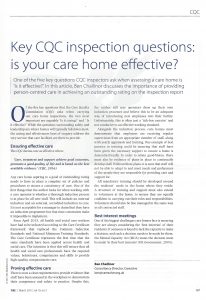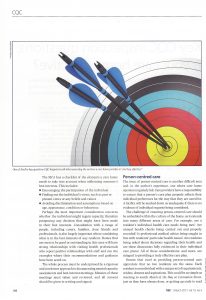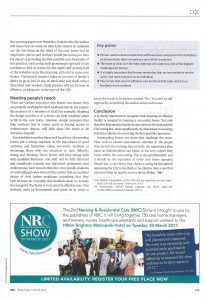Of the five key questions that the Care Quality Commission (CQC) asks when carrying out care home inspections, arguably the two most important are: Are they caring? Are they effective?
While the questions surrounding safety and leadership are the two were homes will typically fall down most, the caring and effectiveness issues get to the nub of the service our care facilities are there to provide.
So what makes an effective care home and what does it take to give yourself the best chance of achieving not just a good CQC rating, but an outstanding one?
The CQC says: “By effective, we mean that people’s care, treatment and support achieved good outcomes, promotes a good quality of life and is based on the best available evidence”.
Any care home aspiring to a good or outstanding rating needs to have committed staff, but also to have in place a complete set of policies and procedures to ensure a consistency of care.
One of the first things I will look for when working with a care operator is whether a thorough induction process is in place for all new staff. This will include an internal in-house induction and an external accredited induction to care. It is not acceptable for a manager to claim that they have an induction programme but that time constraints make it impossible to implement.
As of April last year, all health and social care workers have to be inducted according to the Care Certificate framework which replaced the Common Induction Standards and National Minimum Training Standards.
The Care Certificate represents the first time that the same standards have been applied across health and social care. The intention is that the new standards will ensure that all health and social care workers have the required values, behaviours, competences and skills to provide high quality, compassionate care.
There is now a clear requirement to provide evidence that staff have been assessed in the workplace to demonstrate their competence and safety to practice.
Despite this, we still come across cases where operators have drawn up their own induction process and believe this to be an adequate way of introducing new employees into their facility. This is often just a tick box exercise and not conducive to an effective working standard.
Alongside the induction process, care homes have to demonstrate that employees are receiving regular supervision from an appropriate member of staff, along with yearly appraisals and training.
One example of best practice in training could be ensuring that staff have been given the necessary support to ensure a home is dementia-friendly.
In order to attain good status, there has to be evidence that management have plans in place to continually develop staff in order that they can meet the needs and preferences of the people they are responsible for providing care and support for. All mandatory training should be developed around the residents’ needs in the home where they reside.
A structure of training and support also has to extend to volunteers to ensure they are equally confident in carrying out their roles and responsibilities. They should be line managed in the same way as all contracted staff.
One of the biggest challenges care homes face is ensuring they are always considering the “best interests” of their residents.
If someone is found to lack the capacity to make a decision and such a decision needs to be made for them, the Mental Capacity Act (MCA) states the decision must be made in their best interests.
The MCA has a checklist of the things a care home needs to take into account when addressing someone’s best interests. This includes encouraging the participation of the individual, finding out the individual’s views (such as past or present views or any beliefs and values) and avoiding discrimination (i.e. not making assumptions based on age, appearance, condition or behaviour). Perhaps the most important consideration concerns whether the individual might regain capacity and therefore the postponement of any decision might be in the person’s best interests.
Consultation with a range of people, including carers, families, close friends and professionals, is also hugely important when considering what is in the best interests of any residents. Homes that are good or outstanding will have strong relationships with visiting healthcare professionals who report positive relationships with staff and are able to cite examples where their recommendations and guidance has been acted upon.
The whole process has to be underpinned by a rigorous and consistent approach to documenting mental capacity assessments and Best Interest meetings. Minutes of meetings need to have been taken and reviewed and all documentation relating to consent needs to have been signed.
The issue of person-centred care is another tricky area and one where a number of care home operators regularly fall down.
It is incumbent upon homes to ensure that a person’s care plan properly reflects their individual preferences for the way in which they are cared for.
A facility will be marked down as inadequate if there is no evidence of individual requests being considered; an example of one requiring improvement is when residents have not been consulted about the way they are cared for in their care plans.
The challenge of ensuring person-centred care is embedded within the culture of a home extends into all sorts of areas. For example, are a resident’s individual health care needs being met? Are annual health checks being carried out and properly recorded? Is professional medical advice being sought in line with residents’ particular health issues? Are residents being asked about decisions regarding their health and are these discussions fully evidenced in their individual care plans?
Homes that are getting person-centred care right really appreciate that no two residents are the same. Each one will have their own unique set of requirements, wishes, dreams and aspirations. This could be as simple as wanting to watch Match of the Day or Coronation Street on TV, just as they have always done or getting up early to read the morning paper over breakfast.
Yet I still come across horror stories in which the wishes of residents are the last thing on the mind of the care home and its employees. For example, I have come across homes in which care workers would work together to make life as easy as possible for themselves. I am quite sure practices such as day care workers promising to get half their residents to bed as long as the night workers get half of the residents up in the morning still exists in some care homes. This does not take account of people’s desire to go to bed or rise at times that suit them rather than their care workers!
There are all sorts of ways in which homes can ensure that they are properly meeting the needs of their residents.
For example, are the residents’ needs being met and, even, enhanced by the adaptation, design and décor of a home?
If a home has residents with dementia, are measures being taken to ensure it can be categorised as “dementia-friendly”. This could be as simple as having reminiscence objects in the home.
Food and diet is another big area. Outstanding homes put a strong emphasis on the importance of good nutrition and hydration with innovative methods used to encourage those who are reluctant or have difficulty in eating and drinking. Strong links are maintained with dieticians and staff are fully informed and considerate towards any individual preferences residents’ may have in terms of their desired diet. Residents report that there is excellent choice of food and that mealtimes are something they look forward to.
Crucially, the feedback of residents in the home is actively encouraged, documented and acted upon – another excellent example of person-centred care in action. In care homes, a “you said we did” attitude is something we advocate.
It is so important to run an effective facility. Yes, important in terms of ensuring you are able to achieve the best possible CQC rating but, more important than that, in ensuring that the residents under your care are receiving the best possible experience.
The really outstanding homes are the ones which challenge the norm. They seek to exceed expectations whether this is in the people they recruit, the training they provide, the importance they place on people’s care plans or the very culture they create and foster within their care home setting.
This is the gold standard and it should be the aspiration of every care home operator across the land. It is also what our loved ones have every right to expect every minute of every day.
By Ben Challinor, Co-Founder and Consultancy Director of Caresolve (this article first appeared in the February 2017 issue of Nursing & Residential Care magazine)



